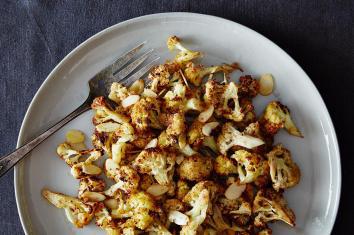Dinner vs. Child is a biweekly column about cooking for children, and with children, and despite children, originally published on Food52 and now appearing on Brow Beat.
Today: When it comes to cauliflower, just toss in spices, add some almonds, and roast. Then let the children have some, too.
Cauliflower is the sort of vegetable that makes children suspicious of vegetables.
Why? Because it lies. It’s white, and according to universal child logic, a white food is a safe food. As if to confirm this, there are almost no other white vegetables. There are potatoes and there’s all-white corn, but those are the least vegetable of vegetables. They’re the exceptions that prove the rule.
There are turnips. (You see my point.) And there’s cauliflower. It may be a safe word—it would be a great safe word, actually—but it is not a safe food. It’s related to Brussels sprouts, for goodness sake.
Also: White asparagus is not a white vegetable. (It’s green asparagus that was locked in the attic by Mr. Rochester.) Kohlrabi is not a white vegetable. (It’s an off-white vegetable. Please.) It comes down to cauliflower and turnips. The point being, you cannot really blame children for feeling like cauliflower has tricked them. Children are pattern-recognizing machines, and they recognized the pattern, and then they made a weird face and went upstairs and ate the rest of their Halloween candy.
For those readers interested in extra credit, I recommend the rather poignant roundtable “White Vegetables: A Forgotten Source of Nutrients.”
This is the part where you’re like, Shouldn’t you be writing about green things instead of white things? And I’m like, Large swaths of Lake Erie are still frozen. Do you know where I took a picnic last weekend? Next to an ice boom.
I feel for the children. Having to be our future is a lot of pressure for anyone. Also, I have never really gotten cauliflower either.
I mean, I like aloo gobi. What rational, self-maximizing actor does not like aloo gobi? But the cauliflower always seems like it is freeloading on the general awesomeness of aloo gobi itself. (Debates about freeloading and the evolution of cooperation always come down to cauliflower, basically.)
Outside of aloo gobi, I was always unconvinced. I was unconvinced by numerous cauliflower soups. I was unconvinced by numerous just-add-dairy cauliflower recipes. These are recipes with a grand French tradition but they always feel a little like school lunch—not the taste but the let’s-hide-this-vegetable-beneath-an-obscene-amount-of-cheese formulation. After eating cauliflower-and-cheese I tend to think, But why not macaroni? Would macaroni have been so wrong?

Photo by James Ransom
I hear you over there saying, Just roast it. And dear Reader: You are so right. In addition to this and this, you should do this: Take cauliflower, tear into florets, toss in spices and oil, roast, add some sliced almonds, roast, eat. The spices are highly flexible; the nuts are flexible; the taste is not.
It’s courtesy of Melissa Clark’s In the Kitchen with A Good Appetite and I am duly grateful. I first made it late at night, thinking it would be a side dish for dinner the next day. It didn’t live past midnight. The second time I was more charitable: I let the children eat some.
Roasted, Spiced, Almond-y Cauliflower
Serves 4
1 large cauliflower, cut into inch-sized florets
½ teaspoon coriander seed
½ teaspoon ground cumin
½ teaspoon ground cinnamon
3 tablespoons olive oil
½ teaspoon kosher salt
3 tablespoons sliced almonds
See the full recipe at Food52.
Previously:
Is It Still Winter Where You Are? Have We Got a Recipe for You!
How to Make Tofu Appealing to Children
Can Peasant Food Prevent Your Children From Becoming Entitled?
Miso Is the Hottest Ingredient Right Now. You Should Love It Anyway.
Is It OK to Feed Your Kids Tuna?
